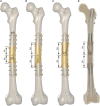Intercalary reconstruction of long bones by massive allograft: Comparison of construct stability ensured by three different host-graft junctions and two types of fixations in a synthetic femur model
- PMID: 35989989
- PMCID: PMC9382195
- DOI: 10.3389/fped.2022.868299
Intercalary reconstruction of long bones by massive allograft: Comparison of construct stability ensured by three different host-graft junctions and two types of fixations in a synthetic femur model
Abstract
An intercalary segmental allograft is an option for limb salvage in bone tumours. Stable and congruent intercalary reconstructions are a prerequisite for achieving host-graft union. However, a too rigid fixation could increase the risk of late complications correlated with negative bone remodelling. This study compared the reconstruction stiffness achieved by three different host-graft junctions, namely, end-to-end, modified step-cut, and taper. A low-stiffness bone plate was used as the fixation method, except for the taper junction where a low-stiffness intramedullary nail was also used to investigate the effects of different types of fixation on construct stiffness. Composite femora were tested under four loading conditions to determine coronal and sagittal bending stiffness, as well as torsional stiffness in opposite directions. Stiffness values were expressed as a percentage of intact host bone stiffness (%IBS). While a reduction of coronal bending stiffness was found with taper junctions (76%IBS) compared with the high values ensured by end-to-end (96%IBS) and modified step-cut junctions (92%IBS), taper junctions significantly increased stiffness under sagittal bending and torsion in intra- and extra-direction: end-to-end 29%IBS, 7%IBS, 7%IBS, modified step-cut 38%IBS, 20%IBS, 21%IBS, and taper junction 52%IBS, 55%IBS, 56%IBS, respectively. Construct stiffness with taper junctions was decreased by 11-41%IBS by replacing the bone plate with an intramedullary nail. Taper junctions can be an alternative to achieve intercalary reconstructions with more homogeneous and, in three out of four loading conditions, significantly higher construct stability without increasing bone plate stiffness. The risk of instability under high torsional loads increases when taper junctions are associated with a low-stiffness intramedullary nail.
Keywords: biomechanical behaviour; bone tumours; host-graft interface; intercalary allograft reconstruction; reconstruction stability.
Copyright © 2022 Baleani, Erani, Blaise, Fognani, Palmas and Manfrini.
Conflict of interest statement
The authors declare that the research was conducted in the absence of any commercial or financial relationships that could be construed as a potential conflict of interest.
Figures





Similar articles
-
Reconstructive Allograft Preparation for Long Bone Intercalary Segments After Tumor Resections: Toronto Sarcoma Protocol.JBJS Essent Surg Tech. 2023 May 24;13(2):e22.00011. doi: 10.2106/JBJS.ST.22.00011. eCollection 2023 Apr-Jun. JBJS Essent Surg Tech. 2023. PMID: 38274144 Free PMC article.
-
An in vitro biomechanical comparison of interlocking nail constructs and double plating for fixation of diaphyseal femur fractures in immature horses.Vet Surg. 2001 Mar-Apr;30(2):179-90. doi: 10.1053/jvet.2001.21396. Vet Surg. 2001. PMID: 11230773
-
A taper-fit junction to improve long bone reconstruction: A parametric In Silico model.J Mech Behav Biomed Mater. 2021 Dec;124:104790. doi: 10.1016/j.jmbbm.2021.104790. Epub 2021 Aug 26. J Mech Behav Biomed Mater. 2021. PMID: 34530302
-
How the Choice of Osteosynthesis Affects the Complication Rate of Intercalary Allograft Reconstruction? A Systematic Review and Meta-analysis.Indian J Orthop. 2021 Nov 10;56(4):547-558. doi: 10.1007/s43465-021-00563-7. eCollection 2022 Apr. Indian J Orthop. 2021. PMID: 35342531 Free PMC article. Review.
-
Biomechanical and biological aspects of defect treatment in fractures using helical plates.Acta Chir Orthop Traumatol Cech. 2014;81(4):267-71. Acta Chir Orthop Traumatol Cech. 2014. PMID: 25137496 Review.
Cited by
-
Effect of Plate Configuration in the Primary Stability of Osteotomies and Biological Reconstructions of Femoral Defects: Finite-Element Study.Bioengineering (Basel). 2024 Apr 24;11(5):416. doi: 10.3390/bioengineering11050416. Bioengineering (Basel). 2024. PMID: 38790284 Free PMC article.
-
Analysis of the Feasibility of the OrthoNail Hybrid Intramedullary Implant in the Human Body with Respect to Material Durability.J Funct Biomater. 2025 Jan 15;16(1):27. doi: 10.3390/jfb16010027. J Funct Biomater. 2025. PMID: 39852583 Free PMC article.
References
-
- Capanna R, Bufalini C, Campanacci M. A new technique for reconstructions of large metadiaphyseal bone defects. Orthop Traumatol. (1993) 2:159–77. 10.1007/BF02620523 - DOI
-
- Capanna R, Campanacci DA, Belot N, Beltrami G, Manfrini M, Innocenti M, et al. New reconstructive technique for intercalary defects of long bones: the association of massive allograft with vascularized fibular autograft. long-term results and comparison with alternative techniques. Orthop Clin North Am. (2007) 38:51–60. 10.1016/j.ocl.2006.10.008 - DOI - PubMed
LinkOut - more resources
Full Text Sources

